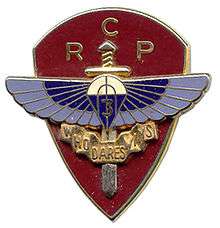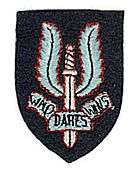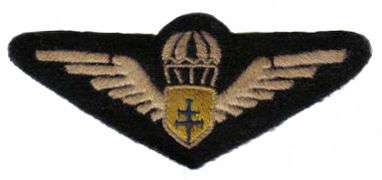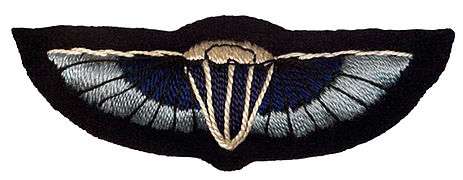3rd Parachute Chasseur Regiment
| 3rd Parachute Chasseur Regiment 3e Régiment de Chasseurs Parachutistes | |
|---|---|
 | |
| Active |
1943 - 1945 1979 - 1998 |
| Country |
|
| Branch | French Army |
| Type | Parachute Infantry |
| Role | Infantry |
| Garrison/HQ |
Brigade SAS 24e DAP |
| Motto(s) | « Who Dares Wins » |
| Engagements | |
| Insignia | |
| Abbreviation | 3e R.C.P |
The 3rd Parachute Chasseur Regiment (French: 3e Régiment de Chasseurs Parachutistes) or 3e RCP, was a French unit of Second World War known, in the British Army, under the designation of 3rd SAS Regiment. Implicated in operation of the Liberation of France and the Netherlands, the unit disappeared temporarily at the end of the conflict and reappeared between 1979 and 1998.
Creation and different nominations
- June 6, 1943 : creation of the 3rd Air Infantry Battalion (3e R.C.P).
- April 1, 1944 : the 3e BIA was designated as 3rd Parachute Chasseur Regiment.
- Summer of 1945 : dissolution of 3e R.C.P. Effectifs are integrated into the 2nd Parachute Chasseur Regiment (2e R.C.P).
- 1979 : unit recreated at the corps of the E.T.A.P.
- 1998 : dissolution of the 3e R.C.P.
- 2006 - 2008 : Commando de Givet center of instruction/training.
History, garrisons, campaigns and battles
Successive garrisons
- Camberly
- Kilmarnock (Scotland)
- Camp d'Auchinlech
- Nantes
World War II
While at the end of 1942, the 1st Air Infantry Battalion was constituted in England at the corps of the Free French Air Forces, Captain Jean-Marie Bouvier, and Captain Fournier, assembled in Caire volunteers of the Free French Forces. The unit which was created in Rouïba Algeria, was transferred to the Tripolitaine in Libya and to Mena Camp in Egypt[1] before rejoining again Rouïba in October with an effectif of almost 600 men.
Officially constituted on June 6, 1943,[2] the 3rd Air Infantry Battalion joined Camp de Camberly in England on November 7. The unit, reduced unfortunately to almost 300 men, was commanded by Captain Château-Jobert.[3]
The 3rd Air Infantry Battalion (3e BIA) and 1st Air Infantry Battalion (1e BIA), which were just redesignated as 4th Air Infantry Battalion (4eBIA), were regrouped at the corps of a Demi-Brigade, commanded by Lieutenant-Colonel Durand, a veteran of the Franc Corps of Africa. Integrated in the British Forces, the two BIAs were incorporated in the Special Air Service Brigade of Brigadier Mac Leod starting December 1943. The 3rd and 4th BIA were designated respectively as 3rd and 4th French SAS Regiments at the corps of the Brigade and the men benefitted access to the various SAS centers of instruction.
The British parachute wings was obtained after eight jumps. The parachute wings insignia received by the formed paras was formulated by Captain Georges Bergé, made out of tissu and conceived on the chest.[4]
At the end of the month of January 1944, the Demi-Brigade was transferred to Scotland (French: L'Écosse). On April 1, the two BIAs were designated as Parachute Chasseur Regiments (RCP). The 3rd and 4th BIA became then respectively the 3rd Parachute Chasseur Regiment (3eRCP) and 2nd Parachute Chasseur Regiment (2eRCP) respectively.[5]
The mission of the SAS is a commando oriented nature. Contrary to the classic parachute troops, the mission was not to engage the ennemy directly but to operate behind the lines in sabotage, clandestine and harceling missions. With really no main rear combat support, missions were led by small units, which engaged and unfolded while leading combats quickly.[6]
The composition of a regiment SAS, which sized the neighbouring strength of a large infantry battalion, was in theory about 600 men spread[7] in:
- one command company (squadron) composed of a section (troops) of transmission with a 12 team radio, one support section, one protection section and the services
- one motoryzed company with four platoon of 4 jeeps
- three combat companies each with a command section and two combat sections with four groups
The encadrement rate of the unit was twice as superior as that of a regular battalion. Counting actually, sixty to sixty five officers and seventy warrant officers, almost a fifth of the total effectif.[8]
Each man was equipped with a Colt 45, a U.S. dagger, a carbine with folding buttstock or a mitraillette Sten. The collective armement resumed to mitrailleurs Bren guns and anti-tank arms type Bazooka or PIAT.
While the 2nd Parachute Chasseur Regiment was deployed in Bretagne during the operations of disembarking on June 1944, the 3rd Parachute Chasseur Regiment was held temporarily in England. The 3rd Parachute Chasseur Regiment was entrusted with action covering the southern flanc of the U.S. 3rd Army which just disembarked in Normandy making way west across the country. Between July 16 and October 7, 1944, the regiment was dropped on France along the line Nantes-Lyon. The mission of the regiment was to contain an opposing force of almost 100,000 men making way to the north.[9]
An initial detachment, at the orders of Captain Simon and constituted from a reinforced squadron, a Demi-Squadron and from the 3rd squadron intervened in le Poitou and limousin from mid-July, made way on Châteauroux and Issoudun beginning of September, before regrouping beginning of October south of poche de Saint-Nazaire.
The 2nd squadron of Captain Pierre Sicaud was first parachuted on the Finistère in the night of the 4 to 5 August (region of Plougastel-Daoulas, Landerneau et Morlaix). The mission consisted of protecting the necessary bridges in order to assure the progression of U.S. Armoured American Units. The 2nd rejoined the 1st squadron and the command Demi-Squadron which remained deployed since August 12 around the cities of Lyon, Chalon-sur-Saône, Autun et Saint-Étienne.
Following a regroupment in the region of Ay Dizy then at Épernay, the 3e RCP paraded in Paris on November 11, 1944. The effectif of the regiment was eloquent: 39 killed in action or disappeared and 72 wounded in action for having placed 6,416 opposing forces out of combat, as well as 20 opposing tanks, 11 trains and a number of vehicles.[10]
The two French SAS regiments were then engaged in the Netherlands in Operation Amherst. The 696 SAS operators were parachuted on 19 different Landing Zones (L.Z)[11] spanning between Ommen et Groningen. They preceded the 2nd Canadian Corps while administering confusion, preventing the opposition of establishing defence lines and mainly also preserving status of bridges.
The operation was a success for the Canadians. The losses for the SAS regiments were heavy and represented more than 20% of the effectifs engaged. Accordingly, the 3e RCP endured the loss of 12 killed, 40 disappeared and 20 wounded.[12]
In June 1945, at the end of the Second World Conflict, the airportable troops left the allied giron. On August 6, the three Parachute Chasseurs regiments and the 4e RIA SAS, which were just reattached permanently to the French Army, were incorporated in the newly created 24th Airborne Division 24e D.A.P.[13]
Returned to their new reserve garrison with the induction of volunteers for the duration of the war, it was not possible to the maintain entirely the units. The 3rd Parachute Chassuer Regiment (3e RCP) was then dissolved and absorbed by the 2nd Parachute Chasseur Regiment (2e RCP with command entrusted to Lieutenant-Colonel de Bollardière.
On October 2, 1945, during an honorary ceremony in honor of the French SAS regiments of the 24th Airborne Division, commanded by général Bonjour, Brigadier Calvert bestowed the Wellington chapeau on the 3e RCP and that of Napoleon on the 2e RCP.
Post War
The 3e RCP was recreated in 1979 at the corps of the airportable instruction center for which the regiment assured to the support and logistics.[14] Eventhough the regiment's principal mission revolved around ensuring the protection of the territory, the regiment was able to be projected hors metropole. In 1996, the regiment was briefly desigatned as "École des troupes aéroportées, the 3e Régiment de chasseurs parachutistes" (ETAP/3e RCP).
The unit was again dissolved in 1998 within the cadre of the reorganization of the armed forces.
The traditions of the 3e RCP were readopted by the Center of Commando Instruction (CEC) of Givet in August 2006 (by dissolution of the 9th Zouave Regiment, a former unit of tradition of the (CEC)) until the dissolve of the latter in 2009.
Traditions
Motto
« Who dares wins » is the general motto of the British SAS, translated in French to « Qui ose gagne ».
Insignia
During the Second World Conflict, the men of the 3e RCP did not dispose of any insignia which was specific to the unit. Incorporated in the British forces, the men's regiment wore British uniforms and harbored on their beret the SAS insignia while carrying on their chest the parachute brevet of the Free French Forces (French: Forces françaises Libres, F.F.L). Sometimes, the SAS wings reward their participation to war operations.
The specific insignia of the 3rd Parachute Chasseur Regiment, 3e RCP wasn't created until the birth of the unit in 1979. The symbolic insignia of the regiment recalls largely the origin of the SAS of the Second World War.
-

Beret Insignia of French SAS
-
 Parachute Brevet of the FFL
Parachute Brevet of the FFLBrevet parachutiste FFL -
Arm patch of the 3e RCP
-

Operational SAS wings
Regimental Colors
The regimental Colors of the French SAS was bestowed to the two Air Infantry Battalions by général Martial Valin of the Free French Air Forces. Entrusted to the Guard of the 4th Air Infantry Battalion 4e BIA, the regimental colors were then transferred to the 2nd Parachute Chasseur Regiment 2e RCP then to the SAS Parachute Demi-Brigade of Indochina, the heir of the 1st Marine Infantry Parachute Regiment, 1 R.P.I.Ma.
The shared SAS Regimental Colors is the most decorated of the Second World War.[15] Colors of the regiment bear wearing:
- Knight of the Légion d'honneur,
- Compagnon de la Libération,
- Croix de guerre 1939-1945 with 7 palsm avec sept palmes,
- Croix de guerre Belge 1939-1945,
- Bronze Star (U.S.),
- Medal dof the Order of the Netherlands Lion, as well as :
- Fourragere with colors bearing the Légion d'Honneur with olive 39-45
- Fourragere T.O.E
- Fourragere of the Compagnon de la Libération since June 18, 1996
Honors
Battle honors
The regimental colors bear the following 7 inscriptions obtained for 7 citations at the orders of the armed forces:
- Crète 1942
- Libye 1942
- Sud-Tunisien 1943
- France 1944
- Ardennes belges 1945
- Hollande 1945
- Indochine 1946-1954
To differentiate the unit, Château Jobert then de Bollardière, nevertheless fabricated specific fanion in 1944 and 1945.
The 3rd Parachute Chasseur Regiment however, 3e RCP received nevertheless the respective Regimental Colors only until February 15, 1982. Inscribed on the regimetal colors of the 3e RCP:
- France 1944
- Hollande 1945
Regimental colors of the 3e RCP are decorated with the Croix de guerre 1939-1945 with 2 palms and bears wearing the Fourragere with colors of the croix de guerre 1914-1918 with olive 1939-1945.
Decorations
The 3e RCP obtained two citations at the orders of the Armed Air Force for action during the Second World War and obtained accordingly two citations croix de guerre with palm. The first citation was bestowed for delivering combats between July 16 and October 7, 1944 for having liberated 9 provinces from Bretagne to Limousin and at Franche-Comté. The second citation was bestowed for actions in the Netherlands as of April 7, 1945 while leading in front of Canadian troops. This last citation was accompanied with the right to bear wearing the fourragere with colors of the croix de guerre.[16]
The unit also obtained on May 9, 1950 for that very same operation, the Royal Dutch Bronze Lion.[17]
Regimental Commanders
- 1943 - 1943 : Commandant Jean-Marie Bouvier
- 1943 - 1944 : Captain the commandant Pierre Chateau-Jobert
- 1944 - 1945 : Lieutenant-Colonel Jacques Pâris de Bollardière
- 1979 - 1981 : Colonel Baulain
- 1981 - 1983 : Colonel Chiama
- 1983 - 1985 : Colonel Menage
- 1985 - 1987 : Colonel Coiffet
- 1987 - 1989 : Colonel Charrier
- 1989 - 1990 : Colonel de Badts de Cugnac
- 1991 - 1994 : Colonel Chanteclair
- 1994 - 1996 : Colonel Bourgain
- 1996 - 1998 : Colonel Menard
- 1998 - 1998 : Lieutenant-Colonel Rideau
Honorary Regimental Arms Celebration
The unit particularly illustrated capability during combats for the Liberation of France and the end of 1944 and combats of the Netherlands in the spring of 1945 (Operation Amherst). These two arms celebrations are the subject of collective citations and inscriptions on the regimental colors of the unit, with the Netherlands incorrectly referred to as "Hollande".
Notable members of the 3rd Parachute Chasseur Regiment
- Jean-Marie Bouvier (1896 - 1964)
- Pierre Chateau-Jobert (1912 - 2005).
- Jacques Pâris de Bollardière
- Edgard Tupët-Thomé, Lieutenant commandant in second of the 2nd company of the 3rd Air Infantry Battalion
See also
References
- ↑ À l'époque, les FFL n'étaient pas les bienvenus en Algérie
- ↑ Date provenant de la première citation du 3e RCP pour les opérations de libération de la France
- ↑ Dans son livre Feux et lumière sur ma trace, Château Jobert confirme une "sérieuse décantation [...] du personnel pour en éliminer la lie", page 41
- ↑ In Les bérets rouges, pages 134 à 144.
- ↑ In Histoire des parachutistes français, pages 23 à 27.
- ↑ In Opération Amherst, de Franck Segrétain, page 63.
- ↑ In Histoire des parachutistes français, pages 24.
- ↑ In Feux et lumière sur ma trace, page 46.
- ↑ In Histoire des parachutistes français, pages 39 et 40.
- ↑ Les chiffres donnés par Histoire des parachutistes français, pages 41
- ↑ In Histoire des parachutistes français, page 44.
- ↑ In Paras de la France libre, page 279.
- ↑ La 24e DAP est créée le 16 juillet 1945. Les troupes aéroportées quittent définitivement l'armée de l'air et rejoignent l'armée de terre le 1er août, In Chasseurs parachutistes 1935 - 2005 page 64
- ↑ In Chasseurs parachutistes 1935 - 2005 page 192.
- ↑ In Chasseurs parachutistes 1935-2005, page 295.
- ↑ In Chasseurs parachutistes 1935 - 2005 pages 42 et 62.
- ↑ In Chasseurs parachutistes 1935 - 2005 page 62.
Sources and bibliographies
- Paul Bonnecarrère, Qui ose vaincra, Fayard, 1971.
- Pierre Chateau-Jobert, Feux et lumière sur ma trace, Presses de la Cité,1978, ISBN 9782258003910.
- Collectif, Histoire des parachutistes français, Société de Production Littéraire, 1975.
- Pierre Dufour, Chasseurs Parachutistes 1935-2005, éditions Lavauzelle, 2005 - ISBN 2-7025-1287-9.
- Roger Flamand, Paras de la France libre, Éditions Presses de la Cité, 1976 - ISBN 978-2-258-00036-0.
- David Portier, Les Parachutistes SAS de la France Libre 1940-1945, Éditions Nimrod, septembre 2010
- Esquisse d'un bilan réévalué de l'action des parachutistes français en Bretagne : mission militaire et/ou politique ,En Envor, revue d'histoire contemporaine en Bretagne, n°2, été 2013, article en ligne, Olivier Porteau.
- Franck Segrétain, Opération Amherst, avril 1945 le raid des 2e et 3e RCP sur les Pays-Bas. Revue Ligne de front n°24, mai-juin 2010. ISSN 1953-0544
- Edgard Tupët-Thomé, Spécial Air Service, l'épopée d'un parachutiste en zone occupée de 1940 à 1945, éd.Grasset, 1980, 346.p. Réédition par Alain Bétry, éd. Atlante, 2011, 250.p. ISBN 9782246252610
- Serge Vaculik, Béret rouge - Scènes de la vie des commandos parachutistes S.A.S., Éditions Arthaud, 1952.
External links
- Historique du 3e SAS sur le site France libre
- Site consacré aux parachutistes SAS de la France Libre 1940 - 1945
- Site chemin de mémoire parachutistes consacré aux parachutisme militaire
- Site souvenir SAS, dédié aux parachutistes SAS de la France Libre & de la France combattante 1940-1945
- Site de l'Association des Anciens Parachutistes Troupes de Marine et anciens de la Brigade des Parachutistes Coloniaux héritiers des SAS
- Helferin terrible story at Axis History Forum